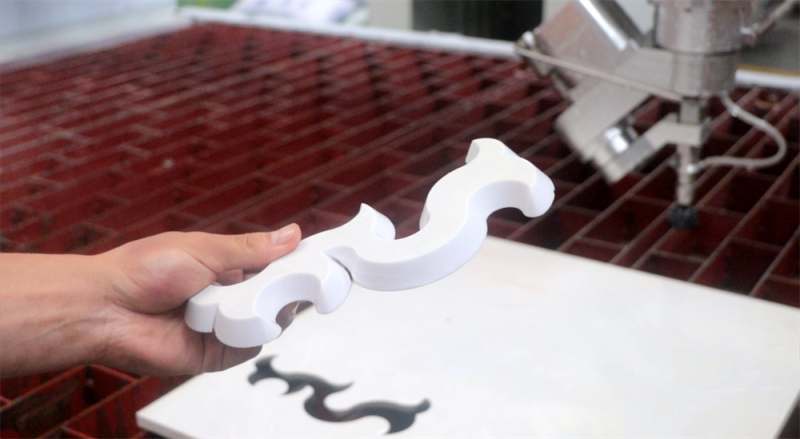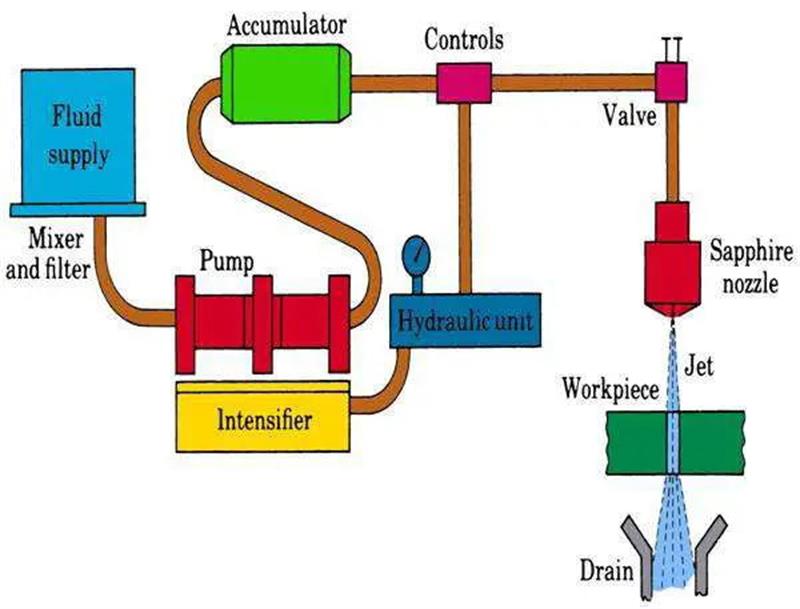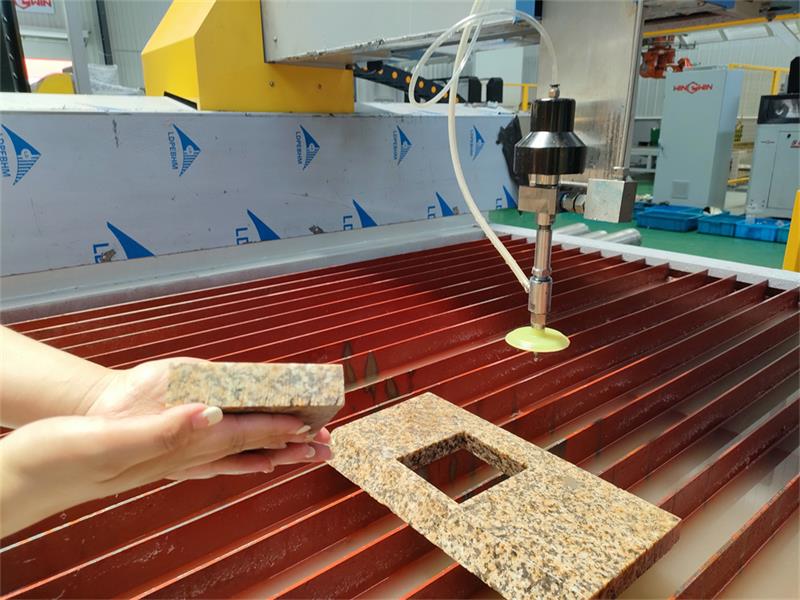Abrasive water jet cutting is a variation of water jet cutting that involves adding abrasive particles, such as garnet, to the water stream to increase cutting power and efficiency. Here are some advantages of abrasive water jet cutting over pure water jet cutting:
Cutting thickness: One of the main advantages of abrasive water jet cutting is that it can cut through thicker and harder materials than pure water jet cutting. The abrasive particles add cutting power and allow for faster cutting speeds, making it possible to cut through materials such as metals, ceramics, and stone that would be difficult or impossible to cut with a pure water jet.
Cutting speed: Abrasive water jet cutting can achieve faster cutting speeds than pure water jet cutting, particularly when cutting through thicker or harder materials. The abrasive particles add cutting power and allow for faster cutting speeds, reducing overall cutting time and increasing productivity.
Cutting precision: Abrasive water jet cutting can achieve high levels of cutting precision and accuracy, even when cutting through thicker or harder materials. The abrasive particles help to maintain a sharp cutting edge and reduce taper, resulting in straighter and more accurate cuts.
Reduced heat-affected zone: Abrasive water jet cutting produces less heat than other cutting methods, such as plasma or laser cutting. This can help to reduce the heat-affected zone around the cut edge, minimizing distortion and other heat-related problems.
Versatility: Abrasive water jet cutting is a versatile cutting method that can be used to cut a wide rangeof materials, including metals, ceramics, composites, and more. This makes it a popular choice for a wide range of industrial and manufacturing applications.
Reduced material waste: Abrasive water jet cutting can minimize material waste by achieving high levels of cutting precision and accuracy. This can help to reduce overall material costs and improve efficiency in manufacturing processes.

Overall, abrasive water jet cutting offers several advantages over pure water jet cutting, including the ability to cut through thicker and harder materials, faster cutting speeds, high levels of cutting precision, reduced heat-affected zone, versatility, and reduced material waste. However, it is important to carefully consider the specific application and material being cut when selecting a cutting method, as pure water jet cutting may still be the best option for certain materials and applications.
Abrasive waterjet cutting is a versatile cutting method that is used in a wide range of applications across various industries. Here are some common applications of abrasive waterjet cutting:
Aerospace: Abrasive waterjet cutting is used in the aerospace industry for cutting materials such as titanium, aluminum, and composite materials. The precision and clean cuts of abrasive waterjet cutting make it ideal for creating complex shapes and intricate designs in aerospace components.
Automotive: Abrasive waterjet cutting is used in the automotive industry for cutting materials such as steel, aluminum, and plastic. The high cutting speed and thickness capabilities of abrasive waterjet cutting make it ideal for cutting automotive components such as gears, pistons, and engine blocks.
Architecture: Abrasive waterjet cutting is used in the architecture industry for cutting materials such as stone, marble, and glass. The precision and clean cuts of abrasive waterjet cutting make it ideal for creating intricate designs and shapes in architectural elements such as flooring, countertops, and decorative features.
Manufacturing: Abrasive waterjet cutting is used in various manufacturing applications for cutting materials such as steel, aluminum, and composites. The versatility and high precision of abrasive waterjet cutting make it ideal for creating complex shapes and parts for various manufacturing industries.
Food processing: Abrasive waterjet cutting is used in the food processing industry for cutting materials such as meat, fruits, and vegetables. The clean cuts of abrasive waterjet cutting make it ideal for food processing applications where hygieneand precision are critical.
Medical: Abrasive waterjet cutting is used in the medical industry for cutting materials such as metals, plastics, and composites. The precision and clean cuts of abrasive waterjet cutting make it ideal for creating medical implants and surgical instruments.
Art and design: Abrasive waterjet cutting is used in art and design applications for cutting materials such as wood, metal, and glass. The precision and versatility of abrasive waterjet cutting make it ideal for creating intricate and unique designs in various art and design projects.

Overall, abrasive waterjet cutting is a versatile cutting method that is used in many different industries and applications. The ability to cut through a wide range of materials quickly and efficiently and the precision and clean cuts make abrasive waterjet cutting an attractive option for many cutting applications.
The main difference between an abrasive waterjet and a pure waterjet is the addition of abrasive material to the waterjet stream. Here are some key differences between the two:
Cutting speed: Abrasive waterjets can cut through materials faster than pure waterjets. The abrasive material adds an extra cutting force that allows the waterjet to cut through materials more quickly and efficiently.
Cutting thickness: Abrasive waterjets can cut through thicker materials than pure waterjets. The abrasive material allows the waterjet to cut through harder and thicker materials, such as metal and stone.
Cutting precision: Both abrasive and pure waterjets are capable of high precision cutting. However, pure waterjets may offer slightly higher precision due to the absence of abrasive material, which can cause slight variations in the cutting path.
Operating cost: Abrasive waterjets may have higher operating costs than pure waterjets due to the cost of the abrasive material and the additional wear on the machine components. However, the increased cutting speed and thickness capabilities of abrasive waterjets may result in overall cost savings for some cutting applications.
Maintenance: Both abrasive and pure waterjets require regular maintenance to ensure optimal performance. However, abrasive waterjets may require more frequent maintenance due to the additional wear on the machine components.
Environmental impact: Pure waterjets are more environmentally friendly than abrasive waterjets, as they do not produce waste abrasive material. Abrasive material must be disposed of properly, which can add to the environmental impactof abrasive waterjet cutting.
the choice between an abrasive waterjet and a pure waterjet will depend on the specific cutting application and the desired cutting capabilities. While an abrasive waterjet may offer higher cutting speed and thickness capabilities, a pure waterjet may be more cost-effective for some applications and still provide high precision cutting. Additionally, the environmental impact of abrasive waterjet cutting should be considered when choosing a cutting method, as the disposal of waste abrasive material can add to the overall environmental impact of the cutting process.

Abrasive waterjet cutting is a versatile cutting method that is used in a wide range of applications across various industries. Here are some common applications of abrasive waterjet cutting:
Aerospace: Abrasive waterjet cutting is used in the aerospace industry for cutting materials such as titanium, aluminum, and composite materials. The precision and clean cuts of abrasive waterjet cutting make it ideal for creating complex shapes and intricate designs in aerospace components.
Automotive: Abrasive waterjet cutting is used in the automotive industry for cutting materials such as steel, aluminum, and plastic. The high cutting speed and thickness capabilities of abrasive waterjet cutting make it ideal for cutting automotive components such as gears, pistons, and engine blocks.
Architecture: Abrasive waterjet cutting is used in the architecture industry for cutting materials such as stone, marble, and glass. The precision and clean cuts of abrasive waterjet cutting make it ideal for creating intricate designs and shapes in architectural elements such as flooring, countertops, and decorative features.
Manufacturing: Abrasive waterjet cutting is used in various manufacturing applications for cutting materials such as steel, aluminum, and composites. The versatility and high precision of abrasive waterjet cutting make it ideal for creating complex shapes and parts for various manufacturing industries.
Food processing: Abrasive waterjet cutting is used in the food processing industry for cutting materials such as meat, fruits, and vegetables. The clean cuts of abrasive waterjet cutting make it ideal for food processing applications where hygieneand precision are critical.
Medical: Abrasive waterjet cutting is used in the medical industry for cutting materials such as metals, plastics, and composites. The precision and clean cuts of abrasive waterjet cutting make it ideal for creating medical implants and surgical instruments.
Art and design: Abrasive waterjet cutting is used in art and design applications for cutting materials such as wood, metal, and glass. The precision and versatility of abrasive waterjet cutting make it ideal for creating intricate and unique designs in various art and design projects.
abrasive waterjet cutting is a versatile cutting method that is used in many different industries and applications. The ability to cut through a wide range of materials quickly and efficiently and the precision and clean cuts make abrasive waterjet cutting an attractive option for many cutting applications.
 wwaterjet
wwaterjet